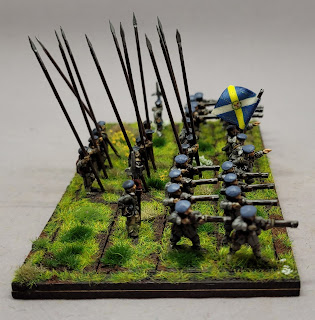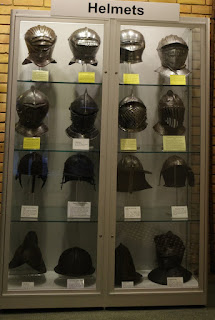If you are 'new' to the Civil Wars there are a number of technical helmet names bandied around by authors and gamers. At the risk of turning into the Ian Allan* armour spotters guide, here is a guide to the different types of helmet commonly used by soldiers during the Civil Wars.
Pikeman's pot, is a bit of a catch all as there are several types of helmet used by pikemen.
The cabascet/cabasset. An older style of helmet, still made in the seventeenth century. Easily spotted by the 'aerodynamic' go faster spoiler at the top of the helmet.
 |
| On display at the Nantwich Museum, from the Grosvenor Museum Collection |
The
morion. Another older style of helmet, anyone who watched episodes of The Flashing Blade during the school summer holidays in the 1970s will be familiar with this style of helmet - those dastardly Spanish wore them.
 |
| A really rubbish picture of an early morion, Combined Military Services Museum |
 |
| A much better picture of a morion, Royal Armouries Leeds |
Morions continued to be made and used during the Civil Wars, however their design evolved into something a little less dramatic. The crest became smaller and the peaks of the brim became less aggressively angled.
 |
| C17th English morion, National Civil War Centre |
Civil War era morions sometimes, but not always, had cheek pieces fitted: this is what most people envisage when they refer to a 'pikeman's pott'.
 |
'Classic' pikeman's armour, National Civil War Centre
(just in case you are wondering, the articulated 'skirt' pieces are called tassets)
|
Secrets, are hidden steel crowns designed to be worn under a 'normal' hat. There are a number of different types. As well as the two illustrated below I have also seen one that was a simple hat band with two straps forming a cross over the top of the head (Cromwell Museum collection). Known in Soctland as "steill bonnets" they were much beloved by Scottish cavalry troopers who wore them beneath their "blew bonnets" (in Scotland a
"secreite" was a canvas jacket which had small steel plates sewn into the lining).
 |
| A 'spider' secret, Royal Armouries Leeds |
 |
| A more common style of secret, Royal Armouries Leeds |
Cavalry helmets: ask anyone to describe what soldiers wore during the Civil War and they will describe a lobster pott helmet. Why are they called lobster pots? First of all the word 'lobster' does not appear to have been used in the C17th in relation to the three bar English pot; its use and popularity looks to be a Victorian affectation. (Lord Byron did describe Haselrigg's Regiment of Horse as a 'regiment of lobsters', but he is referring to their full armour rather than just their helmets.) The term is actually a very good description, as the neck guard does look like a lobster's tail.
The 'classic' lobster pot helmet is an English interpretation of a helmet that was commonly used during the 30 Years Wars, the zischagge. Variously described as being Dutch, Flemish, German or Hungarian in origin they all share a design that looks very familiar to the 'lobster pot'
.JPG) |
| Zischagge, Combined Military Services Museum |
 |
| Zischagge, Royal Armouries Leeds |
All are recognisable by a single, adjustable nose guard.
The same adjustable nose guard appears on a siege hat at West Berkshire Museum (it is displayed back to front).

|
Look carefully at the rear of the hat and you will see the adjuster for the zischagge style nose guard, West Berkshire Museum
|
The zischagge helmet became the
English three bar pot, lobster pot or 'roundhead's helmet'
(shudders), by replacing the adjustable nose guard with a hinged visor that had three connected bars. This design has a few stages, with some subtle differences. They can be identified by their maker's stamp, and these general characteristics:
All of the designs were made from two halves. The earliest version are probably the rarest to find on display, these roughly date from 1630 to about 1650.
Characterised by a central comb where the two halves of the helmet are joined, the peak of the 'visor' slopes down. The bowl of the helmet tends to be deeper than later designs.
.JPG) |
| Early version of an English three bar pott, Fitzwilliam Museum Cambridge |
It is thought that many of these early helmets were modified and updated to an improved design, which appeared 1650-1660. The helmet still has the central comb, but the peak of the 'visor' is much more horizontal. If you see a lobster pott on display in a museum, it is most probably a helmet of this design.
.JPG) |
| Note the horizontal peak of the 'visor', Warrington Museum |
 |
| National Civil War Centre |
 |
| The Littlecote Collection Royal Armouries Leeds - quite tricky to work out which version from this angle isn't it? |
The third design dates from 1660 and is probably the easiest to spot. The helmet is still made from two pieces, but there is no longer a comb where the two pieces are joined along the crest of the helmet, the join is much less visible from afar.
 |
| Royal Armouries Leeds |
There is also a slight variation upon this late design, which has an additional horizontal bar.
 |
| John Bright's armour, Pontefract Museum |
 |
| Can you pick out the two helmets made to the third design of about 1660? The Great Hall, Warwick Castle |
Then there are some oddities that you come across...
 |
| A zischagge that has been given a none articulated three bar face guard, Doncaster Museum |
And some specialist three bar pots...
 |
| Siege armour, this three bar pot is so heavy that it requires shoulder supports, National Civil War Centre. The lack of a visible comb suggests this dates from the 1660s. |
 |
| Facts for the real anorak: the zischagge traces its design back to |
the Turkish 'çiçak' helmet of the C16th. Royal Armouries, Leeds
* for those of you not of a certain vintage, Ian Allan Publishing produced books listing train and bus designs with all relevant identification numbers for bus and train spotters.
If you enjoyed reading this, or any of the other posts, please consider supporting the blog. Thanks.







.JPG)


.JPG)
.JPG)


















Comments
Post a Comment